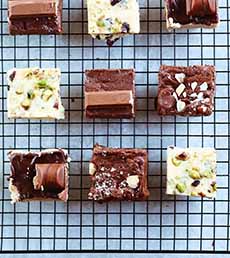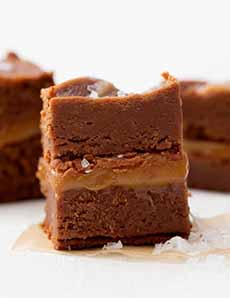Fudge Recipes & Fudge History For National Fudge Day
|
You don’t have to twist our arm to celebrate National Fudge Day, June 16th. We love the stuff—particularly if it’s an elegant recipe (photo #1) that isn’t so cloyingly sweet that we can’t taste the chocolate for the sugar. Or the peanut butter, the vanilla, nuts, etc., etc. Fudge is a drier version of fondant*, an icing made of sugar, water, and cream of tartar. It’s cooked to the soft-ball stage and then kneaded to a smooth, soft paste. The history of fudge is disputed, but an acknowledged American invention. Some food historians peg the date to February 14, 1886, but the exact origin and inventor are disputed. Most stories claim that the first batch of fudge resulted from an accident with a bungled (“fudged”) batch of caramels, when the sugar was allowed to recrystallize; hence the name derived from the interjection, “Oh fudge!” Here’s more of the history of fudge. Now, you can head to the best candy emporium in town and buy yourself some fudge. Or you can take a gander at these recipes. > The History Of Chocolate Why use only one type of chocolate when you can use three? Thanks to Taste Of Home for the recipe. If you don’t like nuts, how about thin pretzel sticks, broken into pieces? 1. LINE a 15x10x1-inch pan with foil. Leave enough foil overlap on the sides so you can lift the finished fudge out of the pain. Grease the foil with 1 tablespoon butter. 2. COMBINE the sugars, milk and cubed butter in a large, heavy saucepan. Bring to a rolling boil over medium heat, stirring constantly. Cook and stir for 5 minutes. Remove from the heat. Stir in the marshmallows and vanilla until blended. 3. GRADUALLY STIR in the chocolate chips and chopped chocolate until melted. Fold in the pecans. Immediately spread into prepared pan. 4. REFRIGERATE for 1 hour or until firm. Using the foil edges, lift the fudge out of the pan. Remove the foil and cut the fudge into 1-inch squares. Store between layers of waxed paper in an airtight container. |
|
|
|
________________ *Fondant can be colored or flavored and used as a center for chocolates, or as an icing for cakes. You may have run into it at a wedding: It’s especially popular as a covering for wedding cakes. CHECK OUT WHAT’S HAPPENING ON OUR HOME PAGE, THENIBBLE.COM.
|
||






